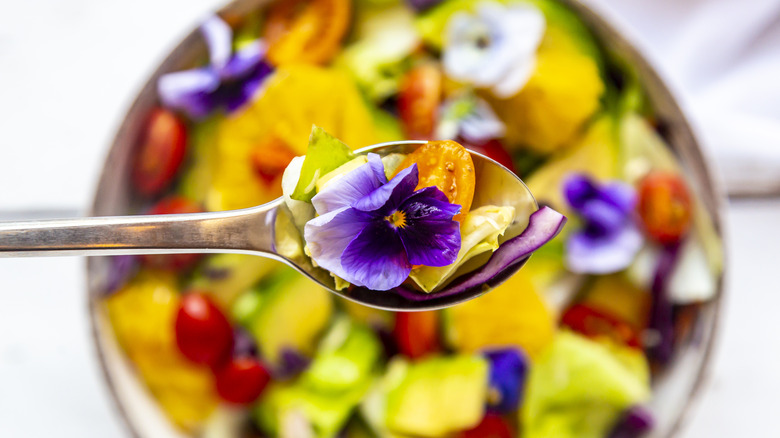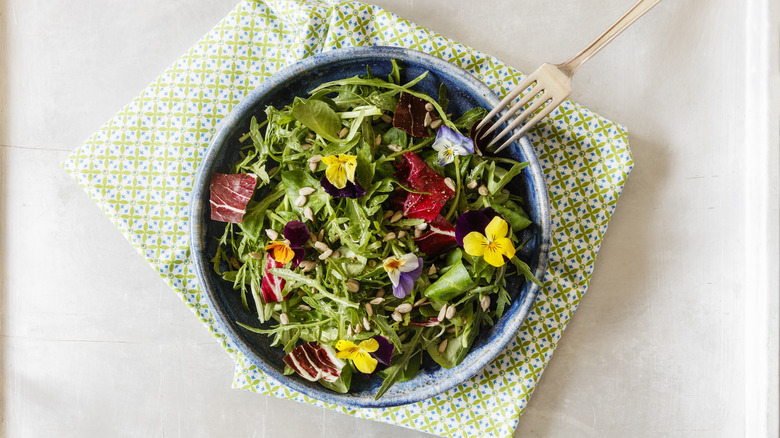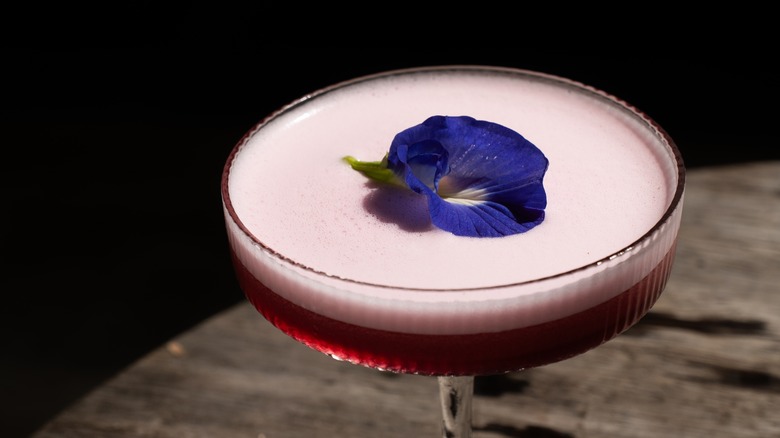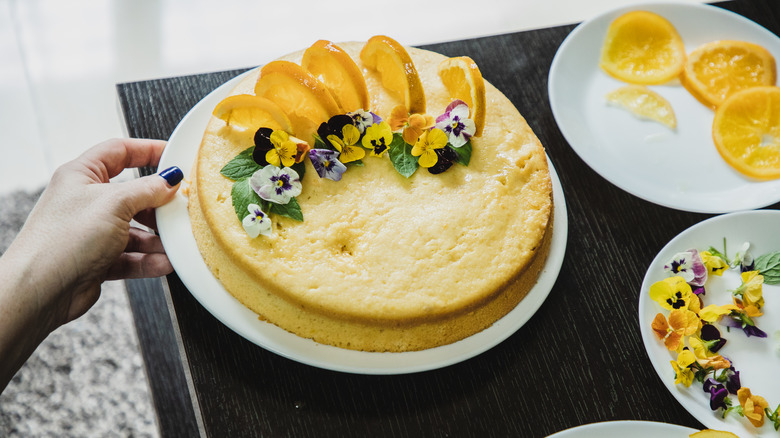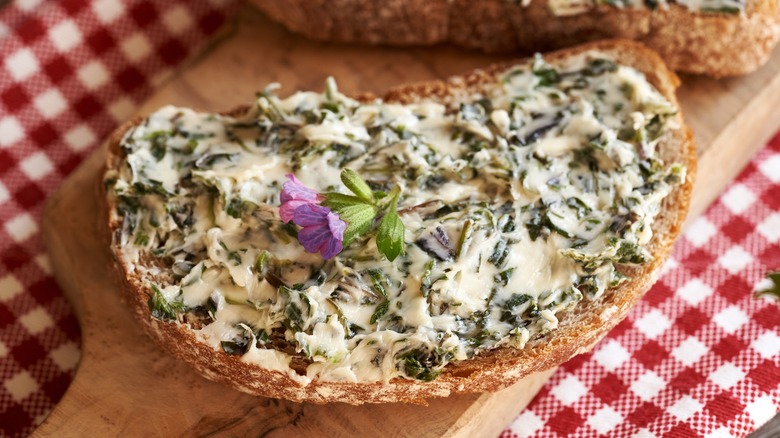Edible Flowers: The Answer To Making All Of Your Meals A Little More Demure And Mindful
"Demure" has become the unofficial word of summer 2024, thanks to TikTok. In an August post, user Jools Lebron became an unexpected meme after describing her workplace makeup style as, "very demure, very mindful." The words have become an internet mantra, enforcing the mentality of subtle elegance above garish maximalism. It didn't take long for the trend to stretch beyond makeup and into the world of food, with content creators posting tutorials on demure table manners and food presentation.
The formal definition of demure, per Merriam Webster, is "reserved, modest." Now, Lebron has added a new layer to the definition by emphasizing elegance, and that rather than being fully reserved, one should adopt an aesthetic that is subtle, yet just enough to catch the eye. In a culinary world where excessive amounts of gold leaf and overflowing milkshakes are taking over, some subtlety is needed for contrast, and if you want to present a dish that is both eye-catching and tasteful, an easy solution is edible flowers.
Edible flowers come in many varieties, but the common theme is that most are small and used sparingly. They are trendy at the moment, but at the same time, these consumable flora have been featured in food for centuries by civilizations like Ancient Egypt, and they've proven to have an enduring, classic look. Edible flowers are also far more versatile than you might expect, so with that in mind, let's look at some of the best ways you can utilize them.
Use edible flowers in salads
Salads tend to be demure in the first place (there are exceptions, of course, like the misunderstood Caesar salad). Oftentimes, salads are a monotone mashup of greenery, and consequently, they suffer from a boring reputation. Adding just a mindful touch of bright color can completely transform the visual presentation, and in the spirit of demureness, it helps to draw the diner's eye to a specific touch of detail, rather than overwhelming their field of vision with excess.
Edible flowers don't just add color to salad either. Depending on the variety you choose, they can also bring their own flavor into play. A good variety to start with would be nasturtiums, as they are arguably the most versatile type of edible flowers. They add a delicate, peppery flavor that complements salad greens well. If you've ever eaten watercress in a salad, nasturtiums add a similar peppery note but with a pop of color to liven things up.
Some of the most popular salad greens come from plants that also produce edible flowers, so why not supplement the leaves with their more eye-catching companions? A popular option here is arugula, which produces small flowers in bright white and yellow colors. The blossoms have the same light peppery taste as the leaves, so they're easy to incorporate into salads.
Garnish a cocktail with edible flowers
Presentation is especially important for cocktails, but again, a certain degree of subtleness is desirable. When decorating drinks with edible flowers, be mindful of the color of the cocktail itself, and choose blossoms with contrasting colors to really make things pop.
You can garnish by simply placing a blossom to float on the surface of the drink, like a lily on a pond, or you can place them on the rim of the glass. If you want to take things up another notch while still keeping it uncomplicated, you can make edible flower ice cubes by placing the blossoms in an ice tray full of water, and use those to chill your drinks.
The most popular flowers for cocktail garnishing tend to be subtly fragrant ones, whose aromas can accentuate drinks without adding too intense of a flavor. Lavender and violas are very popular cocktail garnishes for this reason. For something more flavor-oriented, consider honeysuckle, which has a sweet, honey-scented nectar that you squeeze right out of the flower and into a drink.
Make candied flowers to decorate desserts
If cocktails are the most aesthetic of drinks, then desserts are surely the most aesthetic of foods. As with cocktails, presentation is everything when it comes to dessert. The need to entice the eyes is greater than ever, but so is the risk of going overboard. Adding edible flowers is a great way to find elegant balance when you're decorating cakes, and you can make them extra special by candying the blossoms.
Candied flowers, also known as crystallized flowers, only take a couple of ingredients to make. However, it does require a very delicate touch (one might even say demure) to pull off properly. You'll need edible flowers, egg whites, and superfine sugar (the U.S. name for caster sugar). Thoroughly beat the egg whites with the sugar and then carefully paint the mixture onto the flower petals. Alternatively, you can paint on the egg whites first and then sprinkle superfine sugar on top.
Candied flowers need to dry overnight at room temperature. If you live in a humid environment, it can take a full day or more. You can speed up the drying process by adding a drop or two of vodka to the egg whites. You could even use flavored vodka to add a nice, subtle background note to your desserts. Place these on cakes, ice cream, sorbets, and pastries.
Infuse oil or butter with flowers
Edible flowers are for far more than just garnishing. If you're looking for an eye-catching and creative way to incorporate them into more dishes, consider making a compound butter or infused oil with edible blossoms. To make a floral oil, all you have to do is submerge flower blossoms in a jar of olive oil and give it two to four weeks to infuse. It's a good idea to use flowers from cooking herbs like chives, as those herbs are already popular for infused oils. A flower oil looks best when it's used at the table for dressing salads and dipping bread.
Making a compound butter using edible flowers is even more exciting to the eye, and it can turn the simple pairing of bread and butter into something remarkably elegant. The easiest way to do this is to make a floral butter board by laying down a layer of softened butter and then garnishing it with flower petals and herbs. Alternatively, you can mix softened butter with chopped flower petals and herbs to distribute the color throughout. Then, roll the butter into a log and press whole flowers into the sides for a graceful finishing touch.
Garnish practically any dish
While the aforementioned uses are the most common applications of edible flowers, the reality is that there are hardly any strict rules about how you can use flowers in your food. The one thing to note is that you shouldn't actually cook edible flowers because heat can mute their colors. That's why edible flowers are typically used for garnishing dishes. As far as what dishes you should garnish them with, that's up to you, but we have a few final suggestions you might want to consider.
Edible flowers are a great adornment for toasts, particularly avocado toast, where they add a crucial burst of color to offset what would otherwise be a monotone smear of green. That should certainly make an eye-catching photo to feed the internet's obsession with avocado toast. Keeping with the breakfast theme, you could also use edible flowers to garnish yogurts and parfaits. If you're more interested in a main dish, try out a cool gazpacho with edible flowers. In particular, consider pairing green gazpacho with borage, a bright blue flower with a cucumber-esque flavor.
The kitchen is your playground, so feel free to add edible flowers where you see fit, particularly with fresh produce — both vegetables and fruits. It's best to stick to dishes without an overwhelmingly large array of flavors that would drown the subtle flavors of the flowers. The more delicate and demure the dish, the more the flowers will shine.
